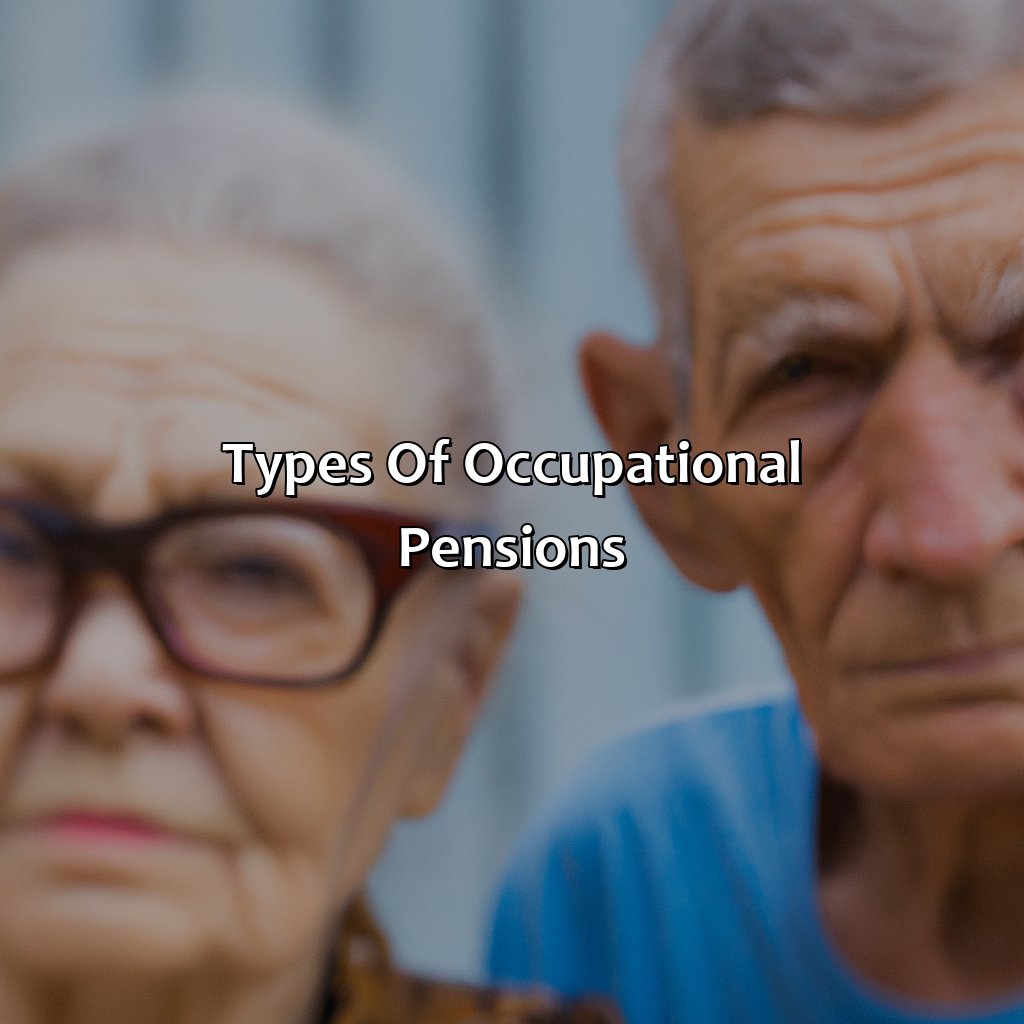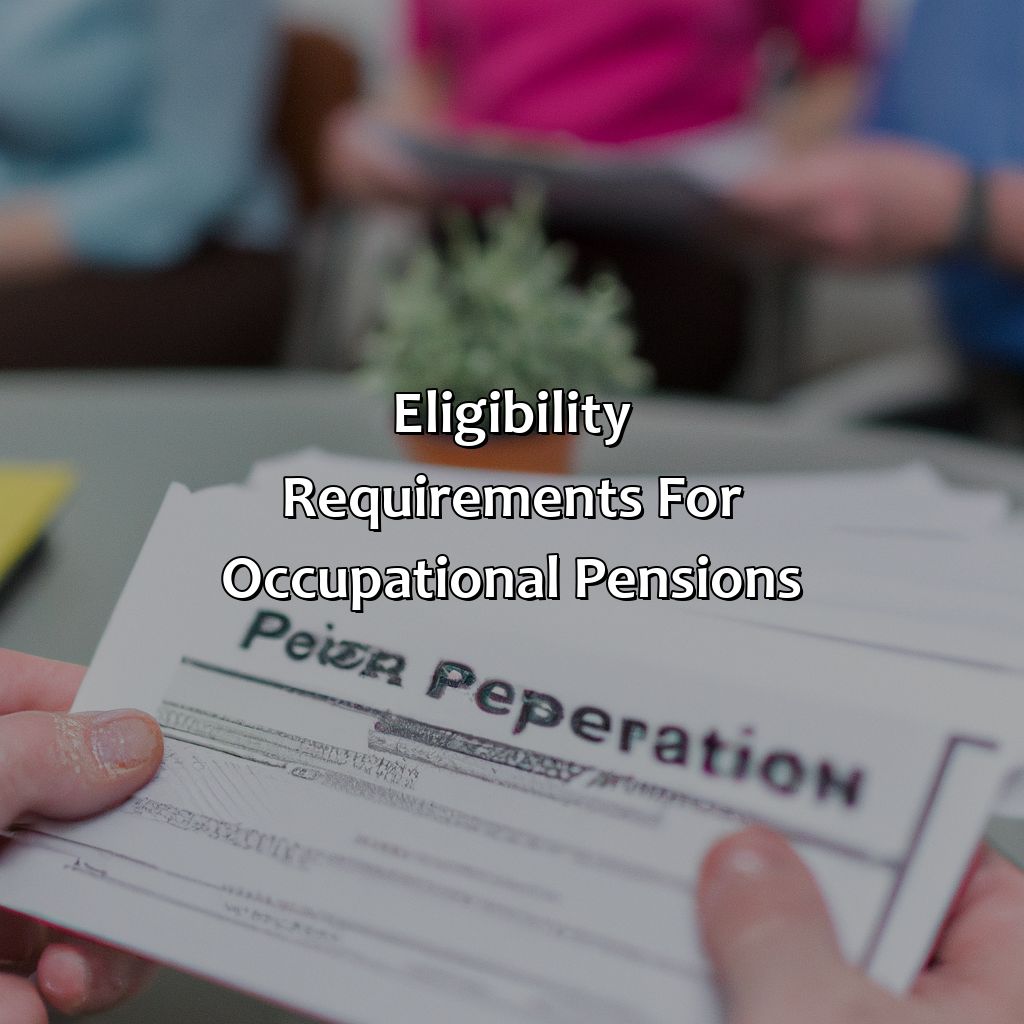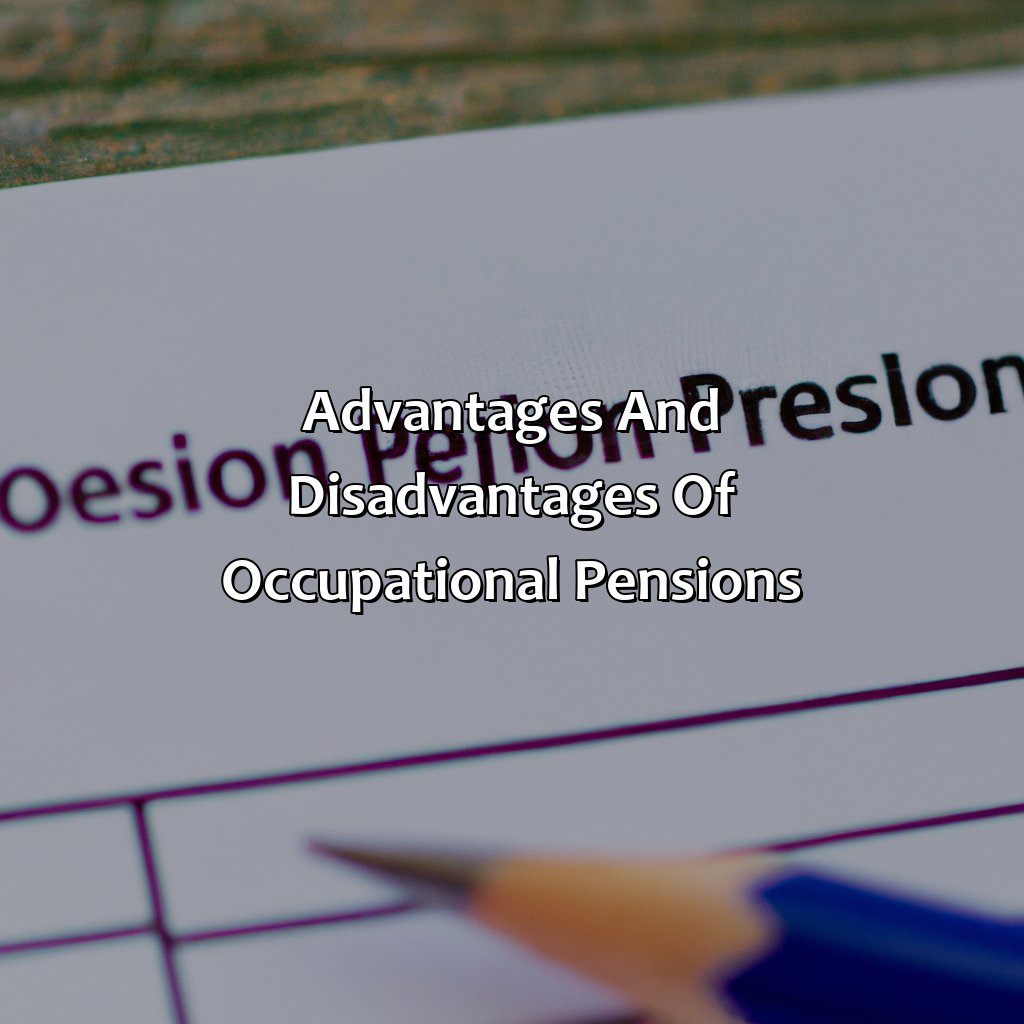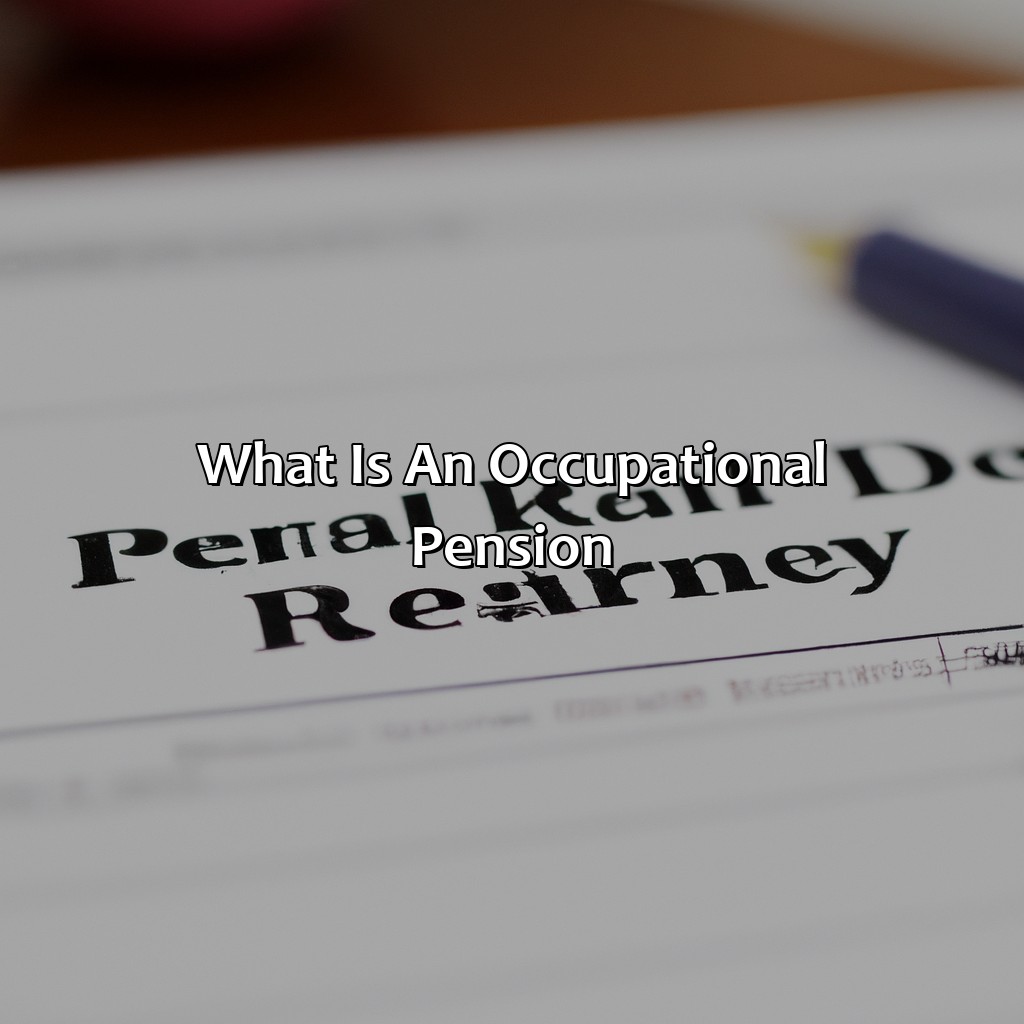What Is An Occupational Pension?
Key Takeaway:
- Occupational pension refers to a retirement plan that is sponsored by an employer and provides employees with a benefit in retirement.
- There are two main types of occupational pensions: defined benefit and defined contribution. Defined benefit pensions offer a guaranteed payout in retirement, while defined contribution pensions depend on investment performance and contributions made by the employee and/or employer.
- Eligibility requirements for occupational pensions typically include a minimum employment duration and/or a minimum age at retirement.
- Funding for occupational pensions can come from both employer and employee contributions.
- Advantages of occupational pensions include retirement security and potential tax benefits. Disadvantages can include limited portability and potential funding issues.
Feeling lost when it comes to understanding an occupational pension? You’re not alone. Let us guide you through the basics and help you make the right decision for your retirement.
Definition of occupational pension
Occupational pension refers to a retirement plan provided by employers to their employees as part of their employee benefits program. This plan is designed to provide a source of income for employees after their retirement. The contributions to the pension plan are usually made by the employer or both the employer and the employee.
The pension plan can either be defined benefit, where the benefit is based on a formula, or a defined contribution, where the benefit is based on the amount contributed to the plan. To understand more about public pension, it is important to know what an occupational pension means.
These plans are regulated and supervised by the government to ensure that employees receive a fair benefit upon retirement. The contributions to the plan are typically invested in a variety of assets, such as stocks, bonds, and real estate. The investments are managed by the plan trustees, who are responsible for ensuring that the fund is managed prudently and in the best interest of the plan members.
As an employee, it is important to understand the terms and conditions of your pension plan, including the eligibility criteria, the vesting period, the contribution rates, and the types of benefits offered. It is also essential to periodically review and adjust your retirement savings plan to ensure that you are on track to meet your retirement goals.

Image credits: retiregenz.com by James Arnold
Types of occupational pensions
For knowledge of the diverse kinds of occupational pensions, delve into the “Types of occupational pensions” area. Here, you’ll find two solutions: “Defined benefit pension” and “Defined contribution pension”. Have a read-through for the basics!

Image credits: retiregenz.com by Joel Jones
Defined benefit pension
A Defined Benefit Plan is a pension plan in which the employer guarantees to pay a specific benefit upon retirement to the employee. This benefit amount can be calculated by considering various factors such as the employee’s salary, years of service, and age.
The contribution for this plan is entirely funded by the employer. As a result, it ensures that employees receive a specific amount of money as per their retirement plans regardless of market fluctuations. If you want to know more about retirement plans, you may want to learn about what is Category A state retirement pension.
In some cases, it may be challenging for employers to fulfill these guarantees if there is an unexpected increase in life expectancy or financial markets’ volatility. However, federal laws have been implemented to protect employees by requiring that pension sponsors maintain adequate funding levels.
Pro Tip: Employers need to ensure proper funding and compliance with regulations to avoid any liabilities during payout phase.
Working hard to contribute to your pension? Good luck with that – just ask anyone with a defined contribution plan.
Defined contribution pension
A pension plan that enforces a fixed contribution rate made by the employer and employee combination, is known as remuneration to defined contribution pension. Employers avoid financial risk here, while retirement outcome has uncertainty. In such plans, employers’ contributions are regularly invested in the market and the converted amount on retirement solely depends on investment returns.
The maximum contribution limits of defined contribution pension are flexible as contrasted to that of defined benefit pension plans. It proposes portability thus being beneficial for employees who keep transitioning jobs as the account balance can be easily shifted. Notably, several employers propose to match their employees’ contributions in such plans up to a certain percentage for increased participation and retention.
Surprisingly, in 2017, nearly 54% of all employer-sponsored pensions were under-defined contribution plans. Though its flexibility may be perceived as beneficial toward employees and employers alike; due diligence must be fulfilled by individuals regarding investment choices assistance provided by employers or advisors.
Reportedly enacted nineteen years ago, The Pension Protection Act aimed at restructuring defined benefit provisions for more natural transfer into a defined pension plan.
Not eligible for an occupational pension? Looks like it’s time to start saving those pennies… for retirement in 2087.
Eligibility requirements for occupational pensions
Need to know if you can get an occupational pension? It’s essential to think about employment length and retirement age. Understanding the criteria for occupational pensions is important. This includes job length and age at retirement. That way, you can get the right benefits for your work!

Image credits: retiregenz.com by Yuval Jones
Employment duration
The duration of one’s work tenure is a crucial factor in determining eligibility for an occupational pension plan. The length of time spent by an employee working for a company impacts their ability to receive such benefits. As a result, potential recipients need to consider their work history and how it relates to the eligibility requirements.
Furthermore, various factors can affect the duration of employment, including taking breaks from work or changing careers. In some cases, employees may be required to work for a specific period before being eligible for a pension scheme.
It is essential to note that these requirements can vary depending on the specific pension scheme and employer. Therefore, those interested in enrolling should review all relevant documentation and speak with HR personnel to determine if they meet the eligibility criteria.
On a historical note, occupational pension plans date back to ancient Rome when soldiers were promised pensions after completing their service to the empire. Today, many companies offer these plans as an incentive to attract talented employees and encourage them to stay for longer periods. If you’re wondering what is a pension check, it’s a form of payment received by retirees from their pension plan.
“You know you’re getting old when you start planning for retirement…but then you realize you never stopped working!”
Age at retirement
The retirement age for an occupational pension varies depending on the specific requirements of the scheme. Typically, the normal retirement age is set at 65, but in some cases, it may be earlier or later. Factors such as length of service, job role and contribution amount can impact eligibility for early or late retirement.
It’s important to note that taking an occupational pension before the specified retirement age can result in reduced benefits. Conversely, delaying retirement beyond the normal retirement age may lead to increased benefits. Some schemes also offer flexible retirement options that allow for a gradual reduction in working hours prior to full retirement. If you want to know more about what is the pension age, you can visit our website.
A notable benefit available with most occupational pensions is tax relief on contributions and investment growth. As such, taking advantage of these schemes as early as possible can significantly enhance one’s pension savings. Wondering what a TPI pension is? Check out our comprehensive guide.
Pro Tip: Be sure to review your scheme’s rules and eligibility criteria early on to maximize your potential benefits.
Fun my retirement? Don’t worry, I’ll just rely on my winnings from the office fantasy football league.
Funding of occupational pensions
To comprehend how occupation pensions work, we must look at contributions from employers and employees. This piece will talk about the significance of employer and employee contributions to secure retirement funds. Employers make a contribution and so do employees. It’s essential for a reliable income in retirement.

Image credits: retiregenz.com by Joel Duncun
Employer contributions
Employers contribute a significant amount towards funding occupational pensions. They are responsible for ensuring that employees receive retirement benefits based on their defined benefit or defined contribution plans. The contributions made by the employer are typically a percentage of the employee’s salary and can vary based on different factors such as age, length of service, and salary level.
In essence, Employer contributions are an investment in an employee’s future financial security. These contributions form the core of pension funds, which are professionally managed to ensure that sufficient assets exist to meet future liabilities. The amounts contributed can be set according to contractual terms or negotiated with employee representatives. If you want to learn more about different types of pensions, you can read about SERP pensions.
It should be noted that in a well-managed scheme, employer contributions will generally cover more than half the cost of pension benefits payable to members. However, there may be times when additional top-up payments may be required, especially where schemes face adverse economic conditions or heightened investment volatility. If you are wondering how a pension is paid out, it varies depending on the type of pension plan and the individual’s preferences.
According to Pension Rights Center, more than 130 million workers in the US alone participate in occupational pension plans, with around $14 trillion invested worldwide in various types of workplace savings plans including defined benefit and defined contribution plans.
Your retirement savings plan: because living off cat food in old age is not a desirable option.
Employee contributions
For the financial stability of an occupational pension, it is essential to understand Employee Contributions. These are payments made by workers towards their future pensions and can vary according to their agreement with the employer.
- Employee contributions serve as a crucial feature of any occupational pension plan as they provide a source of investment for future payout.
- It is customary for employees to contribute a fixed percentage of their salary towards their retirement fund.
- The employer may match or increase these contributions and this additional payment benefits the employee in receiving greater pensions after retirement.
In addition to regular payments, employees have the flexibility to opt-out or change their contribution amounts during certain periods annually. This decision must be communicated to the employer in writing and confers vital benefits on the employee when done correctly.
Historically, there has been much debate about whether employers should force employees to participate in an occupational pension scheme or allow them to contribute voluntarily. Regardless of mandatory participation laws today, it is critical that every worker participates actively in building a secure retirement plan through consistent contributions such as Pay As You Go Pension Plan Employee Contributions.
Occupational pensions: Advantages include feeling financially secure in your old age, while disadvantages include feeling financially secure in your old age instead of living your best life now.
Advantages and disadvantages of occupational pensions
Gaining a better understanding of occupational pensions entails weighing their pros and cons. Let’s compare their advantages and disadvantages. Advantages exist, while drawbacks have their own unique issues.

Image credits: retiregenz.com by Joel Jones
Advantages
Benefits of opting for an occupational pension plan are numerous.
- It offers a sense of financial security and stability to employees after retirement.
- Secondarily, it provides tax benefits in most countries, saving money for both employers and employees. Moreover, the contributions made towards an occupational pension plan are exempted from income tax until withdrawal.
- Additionally, occupational pensions offer various investment opportunities to the employee to make their savings grow faster.
- Some plans also ensure that pensions increase in line with inflation rates, promising a higher payout at retirement.
- Another advantage is that employers sometimes match employee contributions or pay extra into the pension funds.
It is important to understand the risks associated with putting all savings into one investment fund and not being able to access these funds until retirement. It is crucial for employees to continuously review their pension plans and check if they meet their retirement goals before signing up.
To optimize one’s pension plan returns, employees can:
- start contributing early in their careers
- spread risk by diversifying investments
- consider professional financial guidance
By understanding the advantages and disadvantages of an occupational pension plan, employees can make informed decisions and strategically plan for their future retirement goals.
Disadvantages
Occupational Pension Plan Drawbacks
Occupational pension plans come with their fair share of downsides. Here are a few to consider:
- Limitations on Portability: Occupational pensions are linked to a specific employer, and the employee may lose them if they change jobs or retire before the retirement age.
- Risk associated with investment: While occupational pensions can be beneficial in providing retirement income, there is an inherent risk associated with them as they involve investments in stocks and other securities that can decrease in value.
- Restrictive options: Employees may not have control over their pension contributions as employers manage these plans which could limit flexibility and choice when it comes to the investment options available.
It should also be noted that some employees do not qualify for occupational pensions depending on their employment terms and conditions. This limited eligibility might leave others without this benefit.
If you’re considering applying for an occupational pension plan, consider the limitations attached to it before making your decision. You might opt for other forms of investment that offer more flexibility.
Five Facts About Occupational Pension:
An occupational pension is a retirement plan set up by an employer on behalf of their employees. (Source: Money Advice Service)
The contributions towards an occupational pension are made by both the employer and the employee. (Source: Pension Wise)
The pension benefits received in retirement are based on factors such as the employee’s salary, length of service, and pension scheme rules. (Source: Gov.uk)
Occupational pensions are often defined benefit schemes, which means that the benefits received in retirement are predetermined based on certain factors. (Source: BBC)
In recent years, there has been a shift towards defined contribution schemes, where the pension benefits received are based on the return on investments made with the pension contributions. (Source: The Guardian)
FAQs about What Is An Occupational Pension?
What is an occupational pension?
An occupational pension is a retirement plan that is offered by an employer. It provides employees with a fixed income during retirement, which is based on their salary and length of service with the company.
How does an occupational pension work?
An occupational pension works by taking contributions from an employee’s salary and investing those funds in a pension fund. This money is then used to pay the employee a regular income during retirement.
What are the benefits of having an occupational pension?
The benefits of having an occupational pension include having a reliable source of income during retirement, tax advantages, and the ability to save for retirement without having to actively manage your investments.
What are the different types of occupational pensions?
The different types of occupational pensions include defined benefit, defined contribution, and hybrid plans. A defined benefit plan pays out a specified amount of benefits upon retirement, while a defined contribution plan is based on the amount of contributions made and the investment returns earned. A hybrid plan is a combination of both.
Can I opt out of an occupational pension?
It is possible to opt out of an occupational pension, but it is generally not recommended. Doing so means giving up the benefits of having a reliable source of income during retirement and missing out on potential tax advantages.
What happens to my occupational pension if I leave my job?
If you leave your job, you may be able to transfer your occupational pension to a new employer’s plan or into a personal pension account. Alternatively, you may be able to leave the money invested in the plan and continue to receive benefits upon retirement.
 Checkout this IRS Loophole
Checkout this IRS Loophole 
